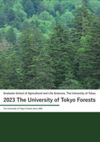HOME > About us
About us
Overview (PDF file 10MB)
The history of the University of Tokyo Forests
The University of Tokyo Forests (UTF) was established in 1894 as an institution attached to the Faculty of Agriculture, the University of Tokyo. In that year, the University of Tokyo Chiba Forest was established in the southeast of the Boso Peninsula as Japan's first university forest.
Following Chiba, branches of the University Forest were established in Hokkaido (1899), Yoyogi (1902~1926), Fuchu (1902~1935), Taiwan (1902), Gangwon-do (1912), Jeollanan-do (1912), Sakhalin (1914), Chichibu (1916), Aichi (Ecohydrology Research Institute, 1922), Hakone (1925), Yamanakako (Fuji Iyashinomori Woodland Study Center, 1925), Hainan Island (1940) and Izu Peninsula (Arboriculture Research Institute, 1943). They were used as locations for forest education and research in environments ranging from shore areas to the subalpine zone, and from the subarctic to the subtropical zone.
After World War II, those University Forests that had been established in foreign countries left the University of Tokyo. The management section of the UTF was handed over to the University of Tokyo Tanashi Forest in 1956. This forest had been established in 1929 when it was called the Tanashi Nursery or Tama Nursery, Faculty of Agriculture, Department of Forestry. The UTF now has seven branch stations.
The UTF, which has various facilities, staff and skills, collaborates with Forest GX/DX Co-creation Center and Executive Office in Yayoi campus to achieving its mission.
The UTF, as a location for education and research, has as its mission the development of technology and human resources for the next generation forest.
The UTF has accumulated valuable data in environment and technology, through conservation and management of forests over 100 years.
The mission statement, which has been developed as "The UTF Master Plan 2007", is to utilize those resources effectively as follows.
Our Mission
To provide a suitable location for forest education for both under-graduate and graduate students. To promote advanced research on the relationship between the natural environment and humans in forests, and to circulate natural environmental data to other research institutes.
To establish an educational system and practical field area for a wide variety of people outside the university, such as children, the elderly and lay persons.
Keywords
1. Forest to lead world in education and research
2. Forest developed by technology
3. Forest to bridge science and the public
Contact us
Please specify your name, affiliation, phone number and what you want to know in the e-mail. Otherwise, we may not be able to respond to inquiries.

